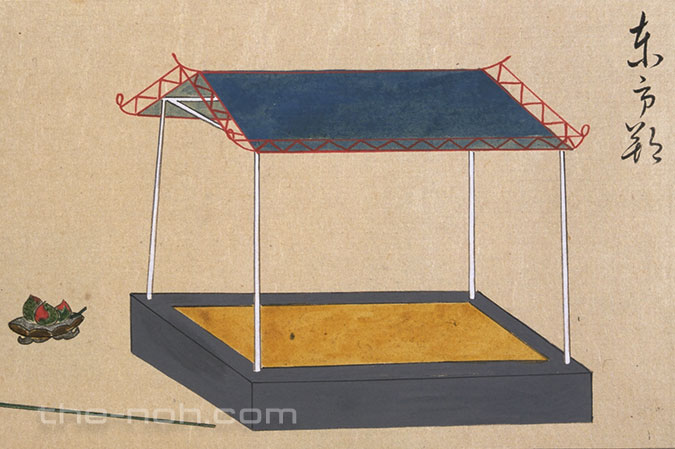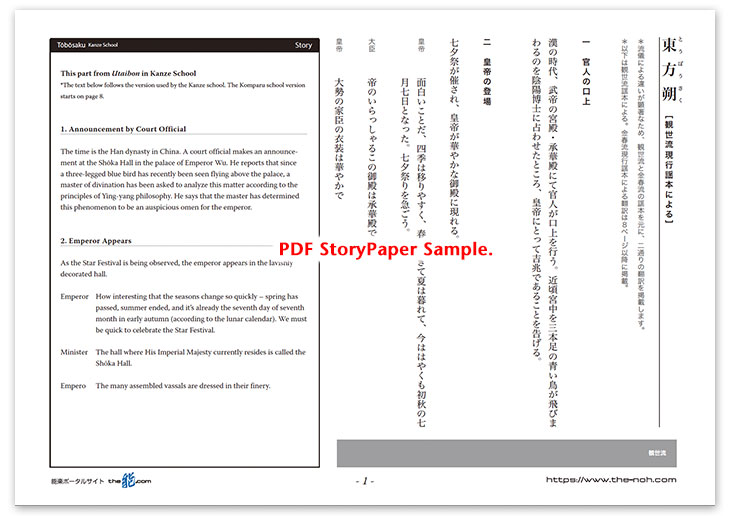
 Tōbōsaku
Tōbōsaku

![]()
In China, during the Han dynasty, a blue bird with three legs was seen flying around the Shōka Hall in the palace of Emperor Wu.
When a master of divination analyzed this event according to the principles of Ying-yang philosophy, he determined it to be an auspicious omen for the emperor. A court official reports this matter at the opening of this play.
On the day of the Star Festival, when Emperor Wu is hosting a party of musical entertainment, an old man, accompanied by a young man, comes to the palace. The old man announces that the appearance of the blue bird is a sign that Xiwangmu, the Queen Mother of the West, will come to see the emperor. The old man also speaks of the peaches that make humans immortal – the medicinal peach tree grown by the Queen Mother of the West that only bears fruit once every three thousand years. He then reveals that he is Tōbōsaku and disappears after announcing that he will again visit the emperor, bringing with him the Queen Mother of the West.
After a Taoist sage and the spirit of the peach make their appearance, Tōbōsaku—who has already attained the age of over 9,000 years old after eating peaches grown by the Queen Mother of the West—comes to see the emperor. Then, the Queen Mother of the West, riding a dragon of beautiful hue, appears and respectfully presents some peaches to the emperor. When the delighted emperor has the musicians play music, Tōbōsaku and the Queen Mother of the West perform a dance. As the sun begins to set in the west, Tōbōsaku and the Queen Mother of the West leave the palace and ascend into the heavens.
![]()
According to legend, this Waki-noh (side noh) was created by Komparu Zenpō, a grandson of Komparu Zenchiku. Although the Kanze and Komparu schools keep this piece in their current repertoires, it is rarely performed. The theme of some Noh dramas reflects the philosophy of Chinese Taoism and Seiōbo (Xiwangmu, the Queen Mother of the West) is a play similar in theme to this one. This play, Tōbōsaku, incorporates the legend of the Queen Mother of the West and Buddhist stories in one drama and has a distinctly congratulatory atmosphere that celebrates longevity.
This Waki-Noh piece is interesting in that it contains many unusual features: the gaku dance performed together by shite (the Taoist sage Tōbōsaku, the lead character) and tsure (the Queen Mother of the West, accompanying character)*; the scene in which a Chinese emperor – waki (supporting character) in this piece – appears, in all his dignity, as music plays (shin-no-raijo); and the scene in which ai plays a significant role. Gorgeous costumes and the effective use of the stage prop hikitate-ōmiya are some of the highlights of this drama, which will fill the audience with blissful sensations.
*There is one set of stage directions in which the shite and waki dance together only in the first instance and shite dances alone for the rest of the performance.
STORY PAPER : Tōbōsaku
Story Paper presents noh chant stories in modern speech, with story outlines, highlights and more using Adobe PDF format, which can print out and zoom in. Print out the pages and take them with you when you see the actual noh performance.

The copyright of Story Paper is held by the Noh.com. Story Paper is for individual use only. It is prohibited by the copyright law to distribute or publish printed-out Story Paper pages without prior consent. For more information, check the credit and disclaimer pages.



 [Tōbōsaku : Story Paper PDF : 485KB
[Tōbōsaku : Story Paper PDF : 485KB